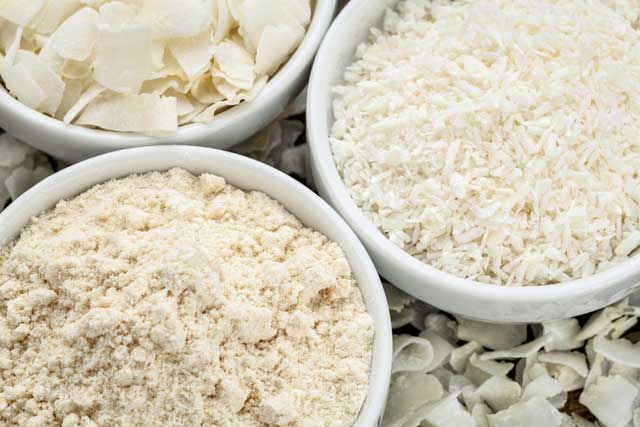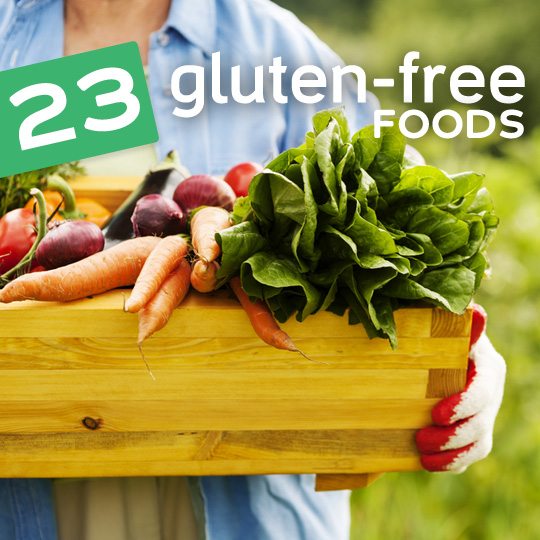Going gluten free can mean giving up many different types of food, but luckily there are still plenty of options available to you. Your biggest culprit will be prepackaged foods that are made with items that contain gluten in them. It’s safe to assume that unless it’s listed as gluten free it likely contains gluten. There are many products hitting the market that are specifically gluten-free, but you’ll want to start off with these whole food sources as a foundation to nutritional eating.
1. Beans
Beans don’t contain any gluten, and are a great food to use for weight management as well as blood sugar management. They are digested slowly by the body, provide fiber, and contain antioxidants, making them a great choice while following a gluten-free diet. Beans are a hearty way to make a meal more satisfying, while at the same time adding a bunch of nutrition to the equation. Mexican food is a great cuisine to enjoy, as long as you replace flour tortillas with corn. It’s easy to go gluten-free, as long as you have a strong understanding of what has gluten and what doesn’t.

2. Eggs
Eggs are a GF food that can be prepared any number of ways, and provide plenty of protein and minerals to help round out your diet. Since eggs show up in so many different dishes it’s easy to make your favorite foods, by just making a few slight adjustments to the way it’s made. For example, you could make a quiche, you’ll just have to replace the all-purpose flour with a gluten-free alternative. Going gluten-free usually doesn’t mean going without, it just means you’ll have to make certain substitutions to make sure the gluten stay behind.
3. Beef
Beef as well as any other meat will contain no gluten, although you may want to go with grass-fed beef to avoid any concern about eating grain-fed beef. This means you can enjoy hamburgers and other beef-heavy dishes, you just have to be sure to pass on the bun with that burger, and cut out items like bread crumbs from dishes like meatloaf. Many find that when they take on a gluten-free diet they automatically lose weight. This is a combination of ceasing the intake of foods that their bodies don’t process well, as well as being more conscious of food in general.
4. Chicken
Chicken is a meat that you can enjoy while eating gluten-free, and this is a good thing since it’s the most commonly found meat in America. We always recommend going organic when selecting your chicken, as it helps to cut out the impurities found in conventional chicken, namely all of the antibiotics and growth hormones. Consider that a perfectly portioned gluten-free meal is as easy as cooking up a chicken breast, serving it with a side of beans and another side of steamed veggies. Avoid fried chicken and any other type of breaded chicken, as it most definitely will contain gluten in the coating.
5. Vegetables
Considering that you can eat any vegetable under the sun while on a gluten-free diet you won’t be hard-pressed to find something to eat. You can partake in the phytonutrient-rich leafy greens like spinach and collard greens, or the many health benefits of cruciferous vegetables like broccoli, cauliflower, and Brussels sprouts. Be on the look out for vegetable casseroles or any other vegetable dish that contains other ingredients besides plain vegetables, as it could contain ingredients that have gluten in them, even though it’s listed as a vegetable dish. Many casseroles will contain bread crumbs or flour as a thickener.

6. Fruit
Fruit can provide your body with plenty of antioxidants, but it will never contain any gluten. Some of the best bets when it comes to fruit are those rich in antioxidants like blueberries and raspberries, or fruits high in potassium and fiber like bananas and avocados. Avocados also provide plenty of healthy fat, making them a great choice as an add-on to any meal. It’s nice to be able to enjoy fresh fruit, just don’t be lured in by fruit pies and other fruit-based desserts that may be served on a wheat-based crust. Always check the additional ingredients if you are considering anything but fresh, raw fruit.
7. All Types of Nuts
Many nuts are an excellent source of healthy polyunsaturated and monounsaturated fats, fats your body needs to actually help it burn fat. Some of the best nut choices are almonds, pecans, walnuts, and pistachios as all of these are loaded with nutrients and healthy fats. These nuts consistently make the list of healthiest foods on the planet, and they’ve been a part of the human diet for thousands of years. Of course, if you also have a nut allergy you’ll want to avoid these, or at least test for a sensitivity before adding them as a mainstay to your diet.
8. All Types of Seeds
Seeds make a great snack, and keep you on the gluten-free side of the equation. They have a nice crunch to them, and many will provide you with additional nutrients. Take chia seeds for example. They contain omega-3s in them. Pumpkin seeds are another great choice for their nutritional value, as well as sunflower seeds. The great feature of seeds is that they can be eaten directly as a crunchy snack, or they can be used as part of a recipe and will still provide their nutrition and flavor.
9. Flax
Flax is a seed, and therefore doesn’t contain any gluten, but it does contain an impressive amount of omega-3s, which you’ll want to consume while leading a gluten-free life. The beauty of flaxseed is its small size, allowing you to sprinkle it on anything you’re eating for added nutrition. You can also easily add it to any soup or smoothie and you won’t even know it’s there. Many gluten-free followers have a bad ratio between the amount of omega-3s and the amount of omega-6s they consume, so something like flaxseed can help to balance that out.
10. Quinoa
Quinoa can be used to replace many of the grains you’ll be giving up on a GF diet, since it doesn’t contain any gluten, yet has many of the same characteristics as grain. It’s been called a “pseudo-grain” because of the way it is processed by the body, but for those looking to cut out the gluten from their diet, quinoa remains a viable asset. The reason quinoa gets so much attention is that it is full of fiber, is a respectable source of protein, and has important minerals like magnesium in it.

11. Kale
Kale has gotten a lot of press in recent years for its many nutritional benefits, and since it doesn’t contain gluten it’s fair game while on a gluten-free diet. Kale is full of vitamins and minerals, has plenty of fiber, and even contains iron. One area that gluten-free dieters often stumble is snacks, with many snack items containing gluten. Try baking up a batch of kale chips the next time you need a crunchy and salty snack. It will give you the crunch of a potato chip, but it will be baked, cutting out all of that oil, and it will have all the nutrition that kale is famous for.
12. Rice
Rice may seem like it has gluten in it, but it’s an entirely different species of plant than wheat, and therefore contains no gluten. You can enjoy a side of rice, rice cakes, or recipes that call for rice, like sushi. Keep in mind that if you are trying to lose weight you may want to go easy on white rice, since it is high in carbohydrates. Stick to brown rice for maximum nutrition and to help with any weight loss efforts.
13. Arrowroot
You might not have been too familiar with arrowroot before going gluten-free, but now that you are it’s a great food to get to know. It’s a starch that is derived from different plants, and you can also find it in flour form. It has a texture similar to wheat, which makes it handy when used in recipes that are trying to replicate wheat-based dishes. If you look at gluten-free recipes long enough it won’t be long until you see arrowroot listed in place of flour or other wheat-derived ingredients.
14. Almond Milk
Almond milk is gluten-free and is a quick way to get vitamins, minerals, and protein into your system. You can add almond milk to a gluten-free fruit smoothie that is loaded with antioxidants.
15. Cheese
Cheese is derived from milk, and is therefore free of any gluten. This means that you can enjoy popular dishes like pizza without worry that the cheese will set you back. Of course you’ll want to make sure you go with a gluten-free crust, but these days many pizza places offer a gluten-free . And since pizza toppings consist of vegetables and meat you can enjoy this food without any concern at all. The longer you stick with a gluten-free diet the more you’ll realize that not much is off limits as long as you make a few easy sacrifices by giving up wheat and foods that contain it.

16. Chocolate
One of the best things about going gluten-free is that you don’t have to give up chocolate. You can have milk chocolate as well, as long as it’s labeled as gluten-free. The added milk and sugar that goes into milk chocolate is free of gluten, but you’ll want to check the label to make sure that there aren’t any other additives that have gluten in them. But we’d recommend going with dark chocolate to reap the benefits of the antioxidants it contains. That way you’ll get your chocolate fix, but also help your body and overall health at the same time.
17. Soy
Soy makes a great break from meat, and comes in many different forms, all of which contain no gluten. Many vegetarians and vegans use soy to replace the meat in their diet, crafting it into things like tempeh and tofu. Whether or not you use these to reduce the amount of meat you eat, they do make healthy alternatives to meat when you want a meat-free meal. Just because an item is listed as being made with soy does not mean it is automatically gluten free. Also verify that the other ingredients are gluten free if ordering at a restaurant, or check the label to see for yourself what else is in it.
18. Butter
Butter is gluten-free, and can be consumed on a gluten-free diet, either in a recipe, as a way to keep foods from sticking to the pan, or spread onto a gluten-free muffin or roll. You’ll want to mix it up with other oils of course, with olive oil or coconut oil being great gluten-free choices. When eating gluten-free you’ll want to expand the number of options you have, rather than contract them. When many GF followers first start out they treat it like a weight loss diet, and get into deprivation mode. It’s best to learn early that your goal is to find suitable alternatives and enjoy the foods you love, just in a different way.
19. Raw honey
Raw honey is gluten-free, which is why you’ll see many candies and other sweet treats listed as Gluten-Free. This is one area where you’ll want to make sure that you are sticking to healthy portion sizes and not overdoing it just because it doesn’t contain gluten. One area you won’t have to sacrifice when it comes to eating gluten-free is desserts. There are plenty of brownies, cookies, candies and chocolates to keep your sweet tooth satisfied, and many gluten-free dessert offerings taste better than their conventional counterparts.
20. Almond Flour
You can use almond flour in place of ordinary all-purpose flour to make baked goods that taste good but still remain gluten-free. Almond flour is a bit thicker and heartier than ordinary flour, and is best used in recipes like cakes, pie crusts, muffins, deep dish pizza crusts, and more. You also end up getting the health benefits of almonds baked right into your items, making them even better for you than if you would have made them with traditional flour. So on top of not filling your body with gluten-full wheat-based products, you will be helping your body out with added nutrients.

21. Coconut Flour
Coconut flour is similar to almond flour in that you can use it to replace general-purpose flour in your baking, while still getting the light and fluffy feel of flour. Since coconut flour is derived from coconuts, it doesn’t contain gluten but it will provide a texture that works great for recipes like cupcakes, pancakes, and pizza crusts that you want to come out flaky and crisp. You’ll also be getting a protein boost from coconut flour, something you do not get from ordinary flour. It also contains fiber, so your baked goods will come with added fiber baked right into them. By going gluten-free you pretty much automatically start leading a healthier life, regardless of a sensitivity or if you have Celiac disease.
22. Salmon
Salmon makes a great addition to your gluten-free lifestyle because it is rich in protein as well as omega-3 fatty acids. A regular gluten-free meal could consist of a salmon fillet served on a bed of quinoa and a side of vegetables. This would provide a satisfying meal, totally free of gluten, with all of the necessary protein, carbohydrates, and fats. A gluten-free chocolatey dessert could round things off, leaving you totally full and in no way feeling deprived. Salmon has been shown to help with heart disease, cancer, and mood, and the omega-3s also help with inflammation in the body, easing discomfort from arthritis and other painful conditions.
23. Peanuts
Peanuts are gluten-free, and they’re a tasty treat while on a GF diet. You can enjoy them as peanut butter just make sure that you buy an organic brand and check that the ingredients are nothing more than peanuts. You can add peanut butter to a smoother to give it added thickness and flavor, or snack on peanuts between meals or at a baseball game without veering off your gluten-free course. As you can see there are plenty of foods you can eat on a gluten-free diet, which is why it’s surprising that so many claim that it is limiting or that it reduces food choices to a minimum.




